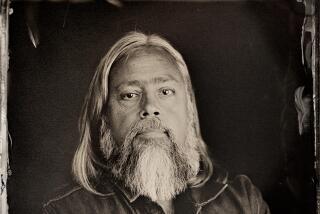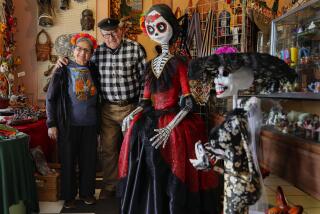Museum Exhibit a Rebirth for Indian Cradles
- Share via
NEW YORK — During the 19th century in the Great Plains, when a Kiowa family learned a baby was about to be born, the mother’s aunt would make a cradle for the child.
For months, the aunt would adorn the cradle with hundreds of glass beads fashioned in the family’s exclusive design. She also would string on red mescal beans that had been collected from trading with tribes in Mexico. Then she would nail metal tacks into the painted cradle board in the shape of a hollow sun.
Leather was fashioned into delicate, twisted fringes that danced with the lightest breeze. Colored quills were made into animal shapes reproduced on both sides of the cradle, which was lined with soft animal fur.
“Life starts with that cradle and it ends with that cradle board,” says Vanessa Paukeigope Jennings, who still makes the ornate cradles at her home near Fort Cobb, Okla.
Her family design is on a cradle depicted in a family photograph from about 1898. Her grandfather, Stephen Mopope, peers from the cradle, which is strapped to the back of Jennings’ great-grandmother, Paukeigope.
The photograph, blown up to giant size, appears as a section of wallpaper at the Smithsonian National Museum of the American Indian in Manhattan, where “Gifts of Pride and Love”--a traveling exhibit of 38 cradles, some over 100 years old--is on display. Two of the cradles were made especially for the exhibit, which closes on May 27 at the George Gustav Heye Center, located in the financial district.
The idea began about four years ago when Barbara Hail, curator of the Haffenreffer Museum of Anthropology at Brown University in Bristol, R.I., wanted to put a face on the people behind the cradle designs portrayed in the photographs. Her work took her to Oklahoma, where Comanche and Kiowa families confirmed their symbols from the photographs. They also agreed to contribute to a book that accompanies the exhibit, which is in its second year of a national tour.
“It was a cause for me to find the makers of the cradles,” Hail says. “The families were so eager to learn where their beautiful pieces had gone.”
Jennings says Kiowa would either bury an individual with the cradle when he or she died, or pass along the cradles to future generations.
The oldest piece in the exhibit is a simple lattice cradle made of leather. It was obtained from a Comanche family in Texas in 1868 during a Smithsonian Institution botany expedition, Hail says. Other cradles are adorned with colorful glass beads, natural dyes and tacks that form patterns of boldly colored flowers and animals, as well as abstract patterns. Jennings demonstrated cradle-making techniques at a reception for the exhibit in March.
“The value was in the love and pride in honoring a new individual coming into the family,” says Juanita Pahdopony-Mithlo, a Comanche who lives in Lawton, Okla. Her family design, a stylized bird pattern outlined with layers of color, appears in the exhibit.
After birth, newborns were wrapped in their elegant cradles. And months later, when they became strong enough, they stepped out of the leather and wood cocoons. Unfortunately, many cradles were sold for food money to pioneers when families ran into difficult times. The cradles then ended up in museums and private collections, and no one would ever know who made the cradle or the person who was nurtured in it.
Pahdopony-Mithlo says some community members initially were wary of revealing family customs and traditional ways to Hail and other researchers.
“How much do you reveal? How much do you share?” Pahdopony-Mithlo asked during a telephone interview from her home. “For me, I’m a little bit more on the sharing side. My view is this exhibit has given a name to these people who are long gone and gives a name to our artists.
“What makes this exhibit so very valuable is the native voice. Museums used to just identify the tribe and that’s it. But it looks like they were interested in the individual artists.”
Jennings says the project required a special person to complete it.
“It needed the tender heart of a woman. Maternal feelings go beyond money; it goes beyond race, it goes beyond class,” Paukeigope Jennings says.
The traveling exhibit began its national tour at the Gilcrease Museum in Tulsa, Okla., in December 1999. It has since traveled to the Heard Museum in Phoenix and to the Fowler Museum of Cultural History in Los Angeles.
After the New York stop, the exhibit will travel to the Oklahoma Museum of Natural History in Norman, Okla., and then to the Mashantucket Pequot Museum and Research Center in Ledyard, Conn.
Hail called the project a success because it involved the artists and their families.
“One woman called cradles ‘a home for the beginning of life,’ ” she said.
*
National Museum of the American Indian: www.si.edu/nmai
More to Read
Sign up for The Wild
We’ll help you find the best places to hike, bike and run, as well as the perfect silent spots for meditation and yoga.
You may occasionally receive promotional content from the Los Angeles Times.






